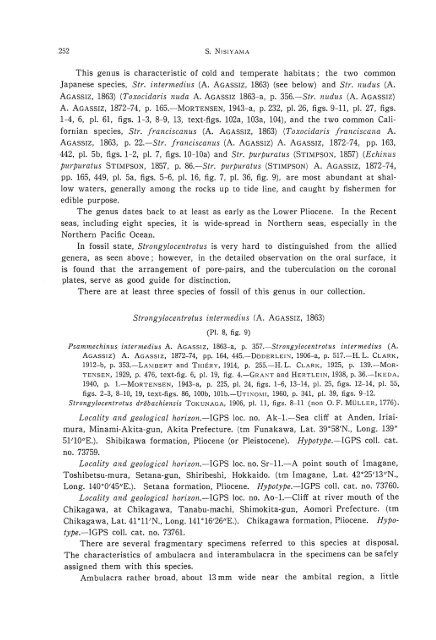the echinoid fauna from japan and adjacent regions part i
the echinoid fauna from japan and adjacent regions part i
the echinoid fauna from japan and adjacent regions part i
Create successful ePaper yourself
Turn your PDF publications into a flip-book with our unique Google optimized e-Paper software.
252 S. NISIYAMA<br />
This genus is characteristic of cold <strong>and</strong> temperate habitats; <strong>the</strong> two common<br />
Japanese species, Str. intermedius (A. AGASSIZ, 1863) (see below) <strong>and</strong> Str. l1udus (A.<br />
AGASSIZ, 1863) (Toxocidaris nuda A. AGASSIZ 1863-a, p. 356.-Str. nudus (A. AGASSIZ)<br />
A. AGASSIZ, 1872-74, p. 165.-MoRTENSEN, 1943-a, p.232, pI. 26, figs. 9-11, pI. 27, figs.<br />
1-4, 6, pI. 61, figs. 1-3, 8-9, 13, text-figs. 102a, 103a, 104), <strong>and</strong> <strong>the</strong> two common Californian<br />
species, Str. franciscanus (A. AGASSIZ, 1863) (Toxocidaris franciscana A.<br />
AGASSIZ, 1863, p. 22.-Str. franciscanus (A. AGASSIZ) A. AGASSIZ, 1872-74, pp. 163,<br />
442, pI. 5b, figs_ 1-2, pI. 7, figs. 10-10a) <strong>and</strong> Sfr. purpuratus (STIMPSON, 1857) (Echinus<br />
purpuratus STIMPSON, 1857, p. 86.-Str_ purpuratus (STIMPSON) A_ AGASSIZ, 1872-74,<br />
pp. 165, 449, pI. 5a, figs. 5-6, pI. 16, fig. 7, pI. 36, fig. 9), are most abundant at shallow<br />
waters, generally among <strong>the</strong> rocks up to tide line, <strong>and</strong> caught by fishermen for<br />
edible purpose.<br />
The genus dates back to at least as early as <strong>the</strong> Lower Pliocene. In <strong>the</strong> Recent<br />
seas, including eight species, it is wide-spread in Nor<strong>the</strong>rn seas, especially in <strong>the</strong><br />
Nor<strong>the</strong>rn Pacific Ocean.<br />
In fossil state, Strongylocentrotus is very hard to distinguished <strong>from</strong> <strong>the</strong> allied<br />
genera, as seen above; however, in <strong>the</strong> detailed observation on <strong>the</strong> oral surface, it<br />
is found that <strong>the</strong> arrangement of pore-pairs, <strong>and</strong> <strong>the</strong> tuberculation on <strong>the</strong> coronal<br />
plates, serve as good guide for distinction.<br />
There are at least three species of fossil of this genus in our collection.<br />
Strongylocentrotus intermedius (A. AGASSIZ, 1863)<br />
(Pi. 8, fig. 9)<br />
Psammechinus intermedius A. AGASSIZ, 1863-a, p. 357.-Strongylocentrotus intermedius (A.<br />
AGASSIZ) A. AGASSIZ, 1872-74, pp. 164, 445.-DoDERLEIN, 1906-a, p. 517.-H. L. CLARK,<br />
1912-b, p. 353.-LA:VlBERT <strong>and</strong> THIERY, 1914, p. 255.-H. L. CLARK, 1925, p. 139.-MoR<br />
TENSEN, 1929, p. 476, text-fig. 6, pi. 19, fig. 4.-GRANT <strong>and</strong> HERTLEIN, 1938, p. 36.-IKEDA,<br />
1940, p. I.-MORTENSEN, 1943-a, p. 225, pi. 24, figs. 1-6, 13-14, pi. 25, figs. 12-14, pi. 55,<br />
figs. 2-3, 8-10, 19, text-figs. 86, 100b, 101b.-UTI;-;OMI, 1960, p. 341, pi. 39, figs. 9-12.<br />
Strongylocentrotus drobachiensis TOKUNAGA, 1906, pi. 11, figs. 8-11 (non O. F. MOLLER, 1776).<br />
Locality <strong>and</strong> geological horizon.-IGPS loco no. Ak-l.-Sea cliff at Anden, Iriaimura,<br />
Minami-Akita-gun, Akita Prefecture. (tm Funakawa, Lat. 39°58'N., Long. 139°<br />
51'10//E.). Shibikawa formation, Pliocene (or Pleistocene). Hypotype.-IGPS colI. cat.<br />
no. 73759.<br />
Locality <strong>and</strong> geological horizon.-IGPS loco no. Sr-1l.-A point south of Imagane,<br />
Toshibetsu-mura, Setana-gun, Shiribeshi, Hokkaido. (tm Imagane, Lat. 42°25'13//N.,<br />
Long. 140 0 0'45//E.). Setana formation, Pliocene. Hypotype.-IGPS colI. cat. no. 73760.<br />
Locality <strong>and</strong> geological horizon.-IGPS loco no. Ao-l.-Cliff at river mouth of <strong>the</strong><br />
Chikagawa, at Chikagawa, Tanabu-machi, Shimokita-gun, Aomori Prefecture. (tm<br />
Chikagawa, Lat. 41°ll'N., Long. 141° 16'26//E.). Chikagawa formation, Pliocene. Hypotype.-IGPS<br />
colI. cat. no. 7376l.<br />
There are several fragmentary specimens referred to this species at disposal.<br />
The characteristics of ambulacra <strong>and</strong> interambulacra in <strong>the</strong> specimens can be safely<br />
assigned <strong>the</strong>m with this species.<br />
Ambulacra ra<strong>the</strong>r broad, about 13 mm wide near <strong>the</strong> ambital region, a little












